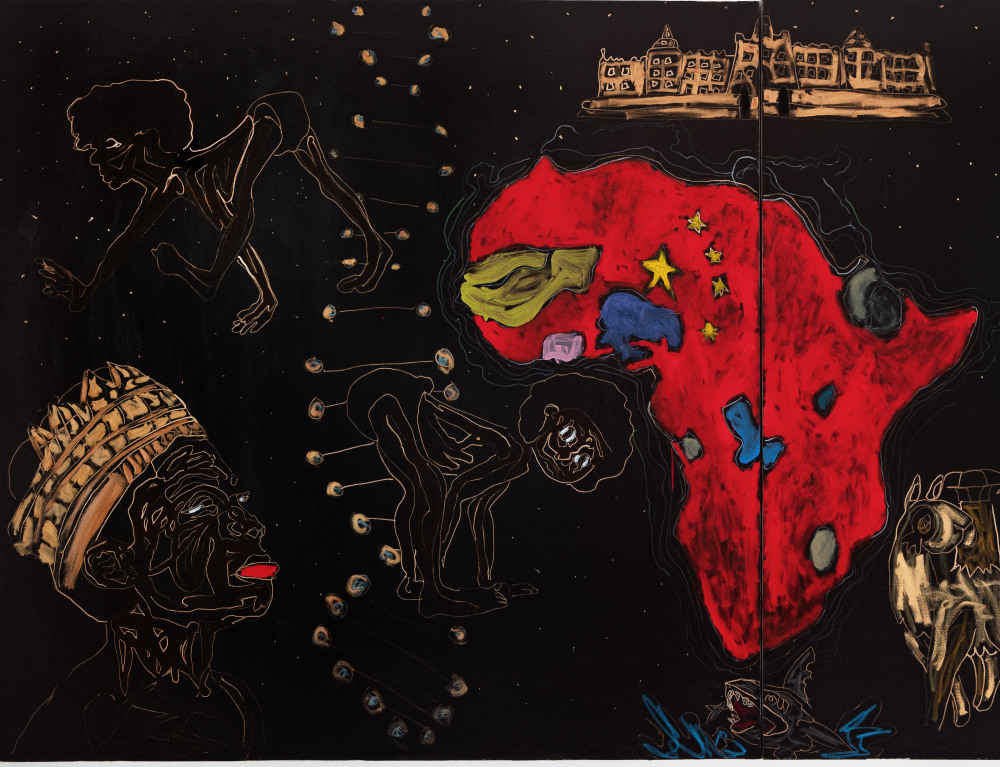
New Orleans artist John Isiah Walton has created 100 paintings that explore the Black experience — and his personal journey — through a comprehensively contemporary lens that touches on everything from Tinder dating to Walton’s Ancestry.com results.
The exhibit, titled “Black Paintings,” can be seen at the Acadiana Center for the Arts Main Gallery until May 13. The works in this series were completed over the past seven years, and many feature Walton’s viewpoint as a native New Orleanian.
One painting depicts the “Renovation Bowl” — a satirical take on the Bayou Classic, the rivalry football game between Grambling State and Southern University at the Superdome. This Thanksgiving event brings thousands of majority Black fans and spectators to the city every year and has drawn attention to some local businesses that announce temporary closings over the holiday weekend.
“Sometimes you’ll have wacky things happen, kids being kids in the city causing ruckus,” he said. “And in response to that, a lot of people will close down their restaurants for renovations over the holiday instead of accommodating these guests from different parts of the community.”
“Black Paintings” also features many of the prominent symbols of digital life. Several works depict binary code, Bluetooth symbols, Google searches and the Meta logo. Walton uses these elements to tell a story about how we choose to represent ourselves in the modern age.
This exhibition at the ACA is the Walton's largest solo exhibition to date.
“We leave our digital footprints within how we communicate with different websites,” Walton says. “I call it digital shadows. I have an account with Yahoo, and if I die, you can pull everything from there. Or you can go back to MySpace if they ever resurrect that and pull all my content from that or Facebook. It’s like leaving a photograph of yourself — but digital.”
Despite being grounded in Walton’s home city, where he still lives and works, “Black Paintings” depicts scenes and themes from beyond New Orleans. He used his Ancestry.com DNA results as a motif in several works, and it is prominent in one painting highlighting themes from Acadiana and southwestern Louisiana.
“The DNA test I took revealed I have Cajun/Creole background in me, and my partner is from the St. Martinville/Lafayette area,” he said. “I went to a few festivals out here and I decided to tap into the whole Zydeco aspect of entertainment.”
In this work, he marries themes of entertainment and religion with a painting of Pinky, the famous albino dolphin from Calcasieu Lake. In this work, “Pinky is being affected by the crude oil in the water out there,” Walton explains. “I wanted to use that idea of water, spirituality, people doing music in Louisiana.”
Jaik Faulk, visual arts director for the ACA, says that he felt it was important to exhibit this series in Lafayette because of similarities he sees with New Orleans.
“Lafayette is in a shifting period,” says Faulk, referencing new businesses, increased interest in neighborhood revitalization, and the growth of institutions such as Festivals Acadiens et Creoles and Festival International.
“John speaks to that transitional period of a place that’s complicated and layered. I think we’re also at a period of time in Lafayette where things are complicated and we’re becoming a more contemporary city as we attract younger generations. Some of the difficult conversations that John raises are going to be worthwhile conversations for those younger generations. I want to showcase artists that speak to that.”